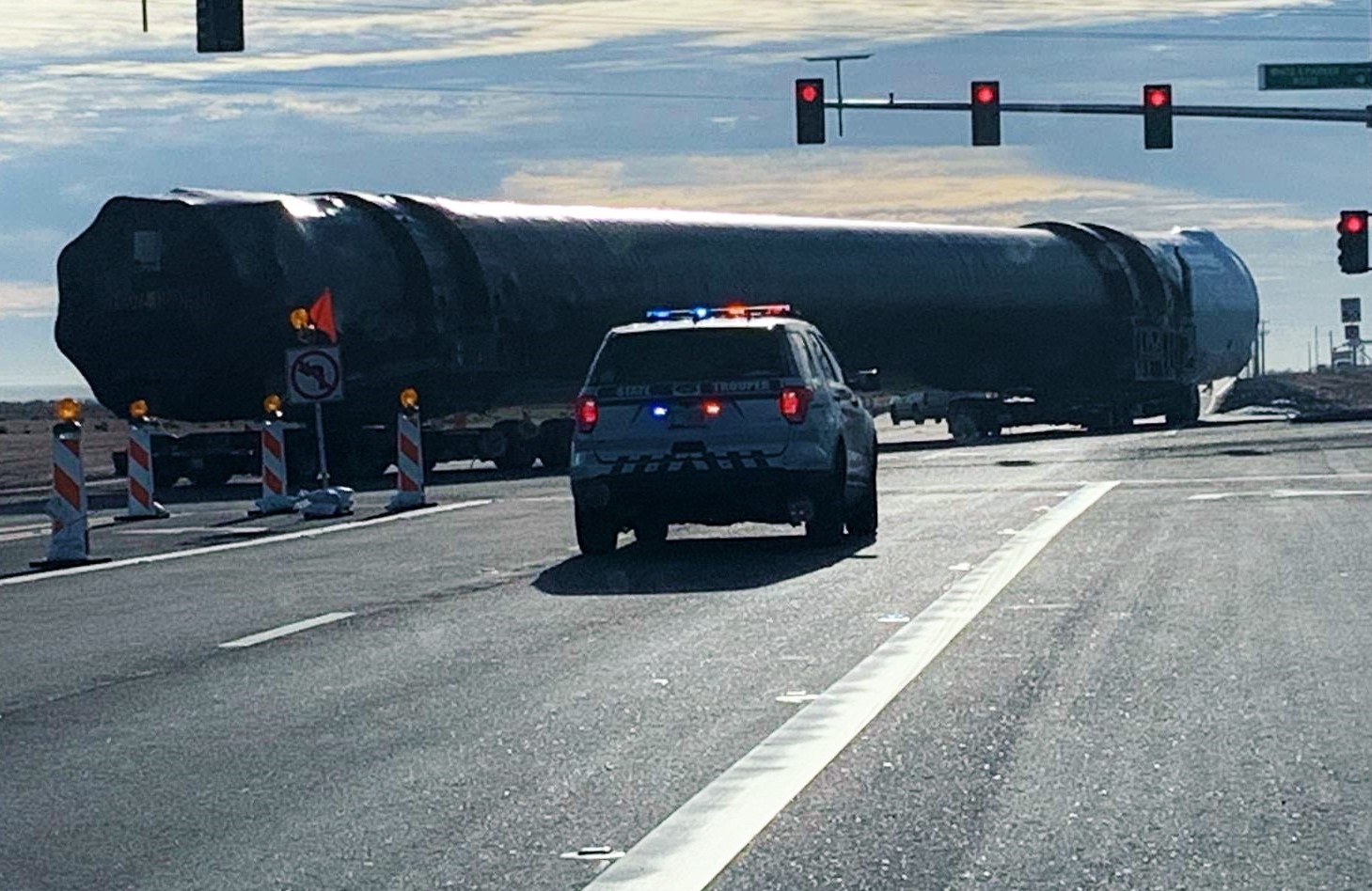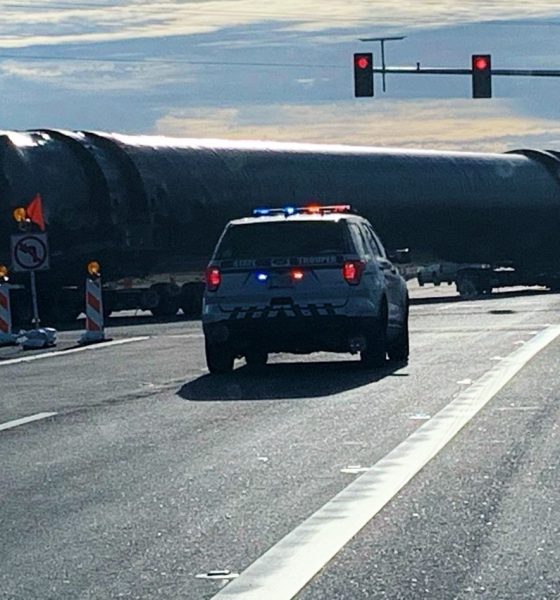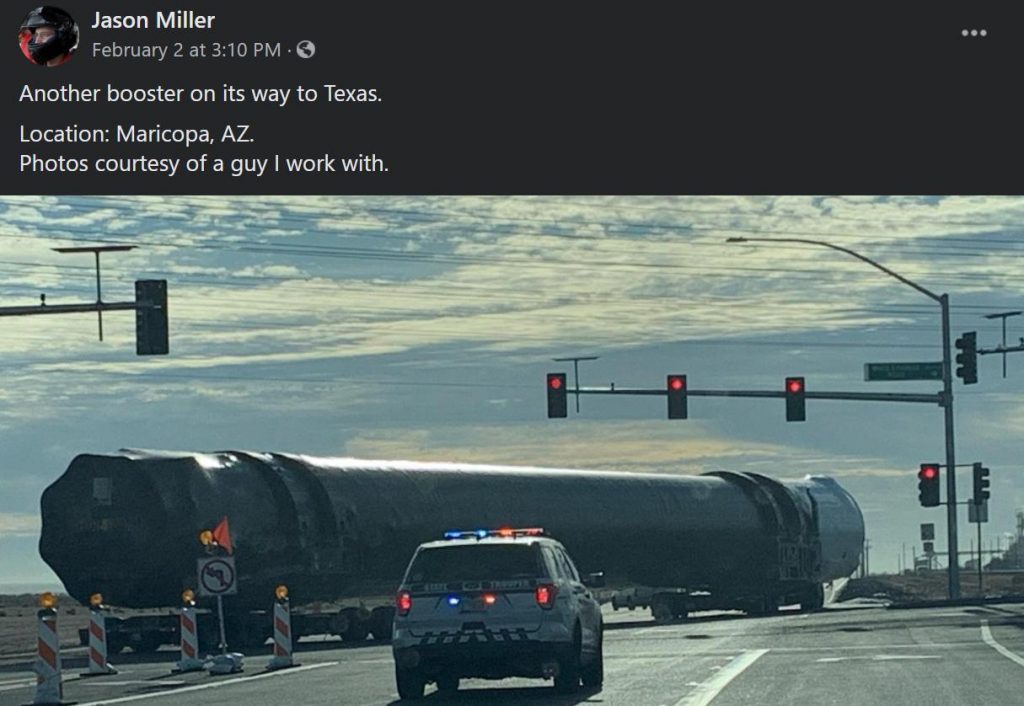

News
SpaceX Falcon Heavy ‘center core’ passes through Arizona on its way to Texas
On the heels SpaceX’s first new Falcon Heavy booster in two years beginning its journey to Florida, another of the rocket’s three first stages was spotted on its way from Hawthorne, California to McGregor, Texas.
Set to be the first Falcon Heavy launch since June 2019, SpaceX is working around the clock to prepare three new first-stage boosters – two side boosters and one ‘center core’ – and an expendable upper stage with a series of static fire acceptance tests at its McGregor, Texas development facilities. Like each of the 60+ Falcon boosters and 110 Falcon upper stages SpaceX has built and launched in the last 11 years, that new Falcon Heavy hardware must pass through a gauntlet of tests before the company deems them fully complete and ready for flight.

Before – or during – the process of actually fabricating and assembling the airframe of Falcon boosters and upper stages, SpaceX first manufactures their respective Merlin 1D (M1D) and Merlin Vacuum (MVac) engines and ships those individual engines to McGregor, Texas for acceptance testing. The McGregor team regularly conducts multiple Merlin and Raptor static fire tests daily, nominally firing each engine for anywhere from a few seconds to six or more minutes to guarantee optimal performance and verify their health.
If issues arise during testing, those engines can often be inspected and fixed by on-site engineers in Texas, but there are also cases where misbehaving hardware will be sent back to Hawthorne for more extensive rework before beginning the static fire process again. Eventually, once engines have passed static fire testing, they are shipped back to Hawthorne and installed on their respective boosters or upper stages.
For both stages, a range of cold gas thrusters used to control a booster or upper stage’s orientation in the vacuum of space are also tested in Texas before before final installation. Ultimately, once all individual component and subsystem tests are completed and the hardware has been returned to Hawthorne and installed, every single Falcon booster and upper stage is then shipped right back to McGregor to repeat even more complex static fire acceptance tests.
Once more, if major issues arise, SpaceX can and has return Falcon stages back to Hawthorne for rework. Otherwise, once static fire testing is completed, boosters and upper stages are shipped directly to one of three SpaceX launch pads in Florida and California. All of that exhaustive, multi-stage testing almost invariably ensures that the hardware that actually reaches launch pads is in pristine condition and truly ready for flight, though issues do still slip through the cracks on occasion.
In other words, the Falcon Heavy ‘center core’ spotted earlier this month is in the late stages of qualification testing and has one final hurdle – an integrated static fire – to pass before SpaceX can ship it to Florida to prepare for flight. That static fire testing process will likely last no less than 4-6 weeks. Falcon Heavy’s fourth launch – a mission known as US Space Force 44 (USSF-44) is currently scheduled to launch no earlier than late May or June 2021.

News
Tesla FSD fleet is nearing 7 billion total miles, including 2.5 billion city miles
As can be seen on Tesla’s official FSD webpage, vehicles equipped with the system have now navigated over 6.99 billion miles.

Tesla’s Full Self-Driving (Supervised) fleet is closing in on almost 7 billion total miles driven, as per data posted by the company on its official FSD webpage.
These figures hint at the massive scale of data fueling Tesla’s rapid FSD improvements, which have been quite notable as of late.
FSD mileage milestones
As can be seen on Tesla’s official FSD webpage, vehicles equipped with the system have now navigated over 6.99 billion miles. Tesla owner and avid FSD tester Whole Mars Catalog also shared a screenshot indicating that from the nearly 7 billion miles traveled by the FSD fleet, more than 2.5 billion miles were driven inside cities.
City miles are particularly valuable for complex urban scenarios like unprotected turns, pedestrian interactions, and traffic lights. This is also the difference-maker for FSD, as only complex solutions, such as Waymo’s self-driving taxis, operate similarly on inner-city streets. And even then, incidents such as the San Francisco blackouts have proven challenging for sensor-rich vehicles like Waymos.
Tesla’s data edge
Tesla has a number of advantages in the autonomous vehicle sector, one of which is the size of its fleet and the number of vehicles training FSD on real-world roads. Tesla’s nearly 7 billion FSD miles then allow the company to roll out updates that make its vehicles behave like they are being driven by experienced drivers, even if they are operating on their own.
So notable are Tesla’s improvements to FSD that NVIDIA Director of Robotics Jim Fan, after experiencing FSD v14, noted that the system is the first AI that passes what he described as a “Physical Turing Test.”
“Despite knowing exactly how robot learning works, I still find it magical watching the steering wheel turn by itself. First it feels surreal, next it becomes routine. Then, like the smartphone, taking it away actively hurts. This is how humanity gets rewired and glued to god-like technologies,” Fan wrote in a post on X.
News
Tesla starts showing how FSD will change lives in Europe
Local officials tested the system on narrow country roads and were impressed by FSD’s smooth, human-like driving, with some calling the service a game-changer for everyday life in areas that are far from urban centers.

Tesla has launched Europe’s first public shuttle service using Full Self-Driving (Supervised) in the rural Eifelkreis Bitburg-Prüm region of Germany, demonstrating how the technology can restore independence and mobility for people who struggle with limited transport options.
Local officials tested the system on narrow country roads and were impressed by FSD’s smooth, human-like driving, with some calling the service a game-changer for everyday life in areas that are far from urban centers.
Officials see real impact on rural residents
Arzfeld Mayor Johannes Kuhl and District Administrator Andreas Kruppert personally tested the Tesla shuttle service. This allowed them to see just how well FSD navigated winding lanes and rural roads confidently. Kruppert said, “Autonomous driving sounds like science fiction to many, but we simply see here that it works totally well in rural regions too.” Kuhl, for his part, also noted that FSD “feels like a very experienced driver.”
The pilot complements the area’s “Citizen Bus” program, which provides on-demand rides for elderly residents who can no longer drive themselves. Tesla Europe shared a video of a demonstration of the service, highlighting how FSD gives people their freedom back, even in places where public transport is not as prevalent.
What the Ministry for Economic Affairs and Transport says
Rhineland-Palatinate’s Minister Daniela Schmitt supported the project, praising the collaboration that made this “first of its kind in Europe” possible. As per the ministry, the rural rollout for the service shows FSD’s potential beyond major cities, and it delivers tangible benefits like grocery runs, doctor visits, and social connections for isolated residents.
“Reliable and flexible mobility is especially vital in rural areas. With the launch of a shuttle service using self-driving vehicles (FSD supervised) by Tesla in the Eifelkreis Bitburg-Prüm, an innovative pilot project is now getting underway that complements local community bus services. It is the first project of its kind in Europe.
“The result is a real gain for rural mobility: greater accessibility, more flexibility and tangible benefits for everyday life. A strong signal for innovation, cooperation and future-oriented mobility beyond urban centers,” the ministry wrote in a LinkedIn post.
News
Tesla China quietly posts Robotaxi-related job listing
Tesla China is currently seeking a Low Voltage Electrical Engineer to work on circuit board design for the company’s autonomous vehicles.

Tesla has posted a new job listing in Shanghai explicitly tied to its Robotaxi program, fueling speculation that the company is preparing to launch its dedicated autonomous ride-hailing service in China.
As noted in the listing, Tesla China is currently seeking a Low Voltage Electrical Engineer to work on circuit board design for the company’s autonomous vehicles.
Robotaxi-specific role
The listing, which was shared on social media platform X by industry watcher @tslaming, suggested that Tesla China is looking to fill the role urgently. The job listing itself specifically mentions that the person hired for the role will be working on the Low Voltage Hardware team, which would design the circuit boards that would serve as the nervous system of the Robotaxi.
Key tasks for the role, as indicated in the job listing, include collaboration with PCB layout, firmware, mechanical, program management, and validation teams, among other responsibilities. The role is based in Shanghai.
China Robotaxi launch
China represents a massive potential market for robotaxis, with its dense urban centers and supportive policies in select cities. Tesla has limited permission to roll out FSD in the country, though despite this, its vehicles have been hailed as among the best in the market when it comes to autonomous features. So far, at least, it appears that China supports Tesla’s FSD and Robotaxi rollout.
This was hinted at in November, when Tesla brought the Cybercab to the 8th China International Import Expo (CIIE) in Shanghai, marking the first time that the autonomous two-seater was brought to the Asia-Pacific region. The vehicle, despite not having a release date in China, received a significant amount of interest among the event’s attendees.








